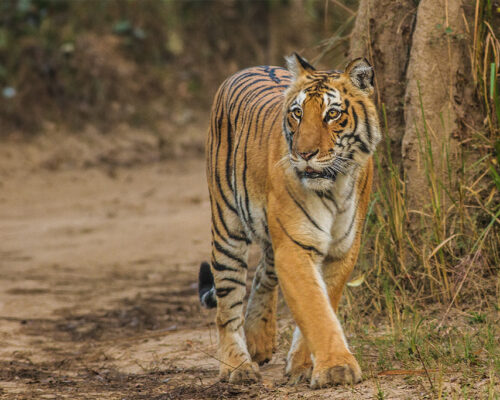Nainital
Nainital is a Himalayan lake resort in the Kumaon region of India’s Uttarakhand state, at an elevation of roughly 2,000m. Nainital is located in the Kumaon foothills of the outer Himalayas at a distance of 285 km from the state capital Dehradun and 345 km from New Delhi, the capital of India.
Commonly known as the “Lake District of India”, Nainital is one of the most beautiful hill stations in North India. Surrounded by mountains on three sides, Nainital is located around the beautiful lake Naini-Tal. This lake resort is situated at a height of 1,938 meters.
Built in 1847, soon after the British arrived, St.John’s Church contains a brass memorial to the victims of a famous landslide. A chairlift (ropeway) takes one up to the popular viewpoint of Snow View (2270 m). At the top, there are powerful binoculars for a close-up view of Nanda Devi, situated 7817 m above sea level.
Nainital is famous for the Naini Lake, the amazing view and the pleasant weather. Some of the other places of tourist interest are the Mall, now known as the Govind Ballabh Pant Marg. You can find restaurants, offices and hotels all located in the Mall. There are good views and spectacular sunsets over the plains from Hanuman temple, 3 km south of Tallital.
Mukteshwar is 33 miles from Nainital presents a panoramic view of the snow-clad Himalayas in early summer and autumn
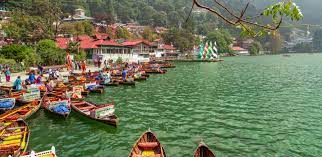
Ranikhet
Ranikhet is a hill station and cantonment town in Almora district in the Indian state of Uttarakhand. North of Nainital at an altitude of 1829 m, Ranikhet is offering excellent views of the snow-capped Himalayas, including Nanda Devi.
Ranikhet, which means Queen’s meadow in Hindi, gets its name from a local legend, which states that it was here, that Raja Sudhardev won the heart of his queen, Rani Padmini, who subsequently chose the area for her residence, giving it the name, Ranikhet, though no palace exists in the area.
In 1869, the British established the headquarters of the Kumaon Regiment here and used the station as a retreat from the heat of the Indian summer.
Ranikhet is famous for the Gandhi Kuti and the temple of Golu Devta. It is a scenic spot with unparalleled beauty situated at a distance of 25 kilometres from Ranikhet. Syalikhet is located in the midst of green forest and apple orchards. The famous temple of Syahi Devi is situated in Syalikhet.
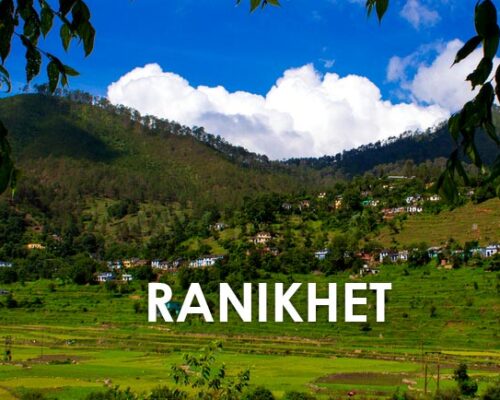
Almora
Almora is a busy hill station in Kumaon hills which is situated at 1,638 metres and is spread across a 5 kilometre long ridge on Kashyap Hill. Surrounded by the dwindling pines and old oaks, the city has a divine natural aura that is enough to allure anyone and everyone. To make the scenery even more mesmerizing, the snow-capped Himalayas stand in utmost grandeur to please the eyes of the admirer. Almora is famous for its rich cultural heritage, unique handicrafts and delicious cuisines
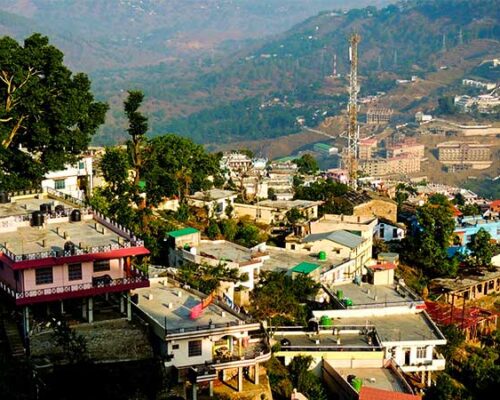
Binsar
Located at a distance of 33 km from Almora, Binsar is a tiny hamlet in Uttarakhand known for the surreal beauty of the snow-laden Himalayan peaks and natural beauty. Perched amidst forests covered with oak, pine, rhododendrons and deodar trees, Binsar is home to beautiful green meadows, temples and the famous Binsar wildlife sanctuary.
Nestled at an altitude of 2,420 m, 95 km from Nainital, Binsar is one of the most scenic hamlets in the Kumaon Himalayas. it offers a majestic view of the snowy Himalayan peaks like the mesmerizing ranges Chaukhamba, Trishul, Nanda Devi, Shivling and Panchchuli.
Binsar is also a trekker’s paradise. Walking amidst the misty mountain trails, towering Oaks and Rhododendrons is a heavenly experience. Encircled by a vast wildlife sanctuary, a home to many rare animals, birds and wildflowers.
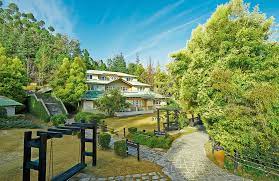
Kausani
Kausani is a hill station (at 1890 m) and village situated in Bageshwar district in the state of Uttarakhand, India.
Nestling amongst thick, dense pine forests, atop a narrow ridge Kausani provides a ringside view to the spectacular magic of nature. The snow-clad peaks of the Himalayas seduce you with their shimmering peaks as the light creates a kaleidoscopic pattern across the skies.
Kausani offers panoramic views of the Himalayan peaks Trisul, Nandadevi, and Panchchuli. Its ethereal sunrise and a 300-km-wide view of the Himalayan range have attracted thousands of visitors to this place time and again.
Nearest railhead to Kausani is Kathgodam (142 km). The hill station is well connected by road to Almora (53 km), Ranikhet (79 km), Nainital (120 km), and Delhi (410 km).
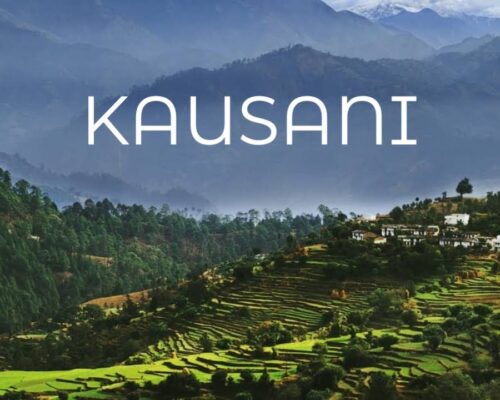
Pithoragarh
Pithoragarh is the easternmost district of Uttarakhand, neighbouring Tibet in the north and Nepal in the east. A place of exquisite natural beauty and serenity, Pithoragarh is popularly known as the ‘Little Kashmir’. This captivating town with fascinating forests around it is located at an impressive height of 1,645 m and is nestled in a small valley. Pithoragarh town is a historical landmark. It was a major center of power during the regime of the Chand Kings in Kumaon. One can have panoramic views of vast snow ranges extending from Trishul, Nanda Devi, Panchachuli group, and Mount Appi of Nepal from the Chandak hill located at around 2000 m.
The town is the north entrance to the Himalayas and gives way to the important pilgrim spots of Kailash and Om Parvat and the holy lake Mansarovar. Due to its location among the hillocks of the mighty Himalayas the town is a popular tourist destination and is famous for its old forts and temples.
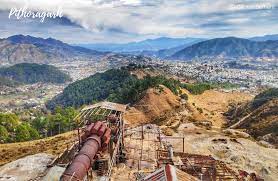
Chaukori
Chaukori, nestled at a height of 2,010 meters. is a dream hamlet in Kumaon hills, surrounded by towering Himalayan peaks and dense forests. This hill station in the Pithoragarh district is set among the lofty peaks of the western Himalayan Range in the Kumaon Division of Uttarakhand. Chaukori offers aromatic tea estates, luxuriant deodar, alpine forests, fruit orchards with the stunning backdrop of Chaukhamba, Nanda Devi, Trishul and Panchachuli peaks; Chaukori is an offbeat destination of Uttarakhand that promises spellbinding views.
Major attractions: Enjoy most photogenic sunrise and sunset views, trek up to Musk Deer Park, Dharampur, Berinag and Patal Bhuvaneshwar.
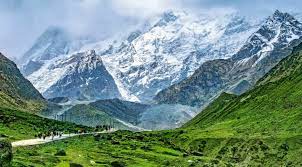
Munsiyari
Munsiyari is the name of the sub-division headquarters, a Sub Division in the Pithoragarh district in the hill-state of Uttarakhand, India.
It is a hill station and lies at the base of the great Himalayan mountain range, at an elevation of about 2,200 m (7,200 ft)and is a starting point of various treks into the interior of the range.
In local parlance, the name ‘Munsiyari’ refers to a ‘place with snow’. Situated on the banks of Goriganga river, it is a fast-growing tourist destination, and mountaineers, glacier enthusiasts, high altitude trekkers and nature lovers commonly use it as their hub or base camp. Munsiyari also falls on the ancient salt route from Tibet and is at the entrance of the Johar Valley, which extends along the path of the Gori Ganga river to its source at the Milam Glacier.
The region is a paradise for nature lovers and adventurous souls. One has a breathtaking view of the Himalayan peak, Panchchuli from here. Munsiyari is the base for the trekkers to Milam and Ralam Glaciers and Nanda Devi peak.
A fast developing centre for skiing and other winter sports, Munsiyari is a fairly big & developed Himalayan township at an altitude of 2,298 m. Inhabited by the Shauka tribes from time immemorial, it lies on the trade route to Tibet.
Munsiyari is at a distance of 135 kms from Pithoragarh and 200 km from Almora. It’s the gateway to the Johar region of inner Himalayas
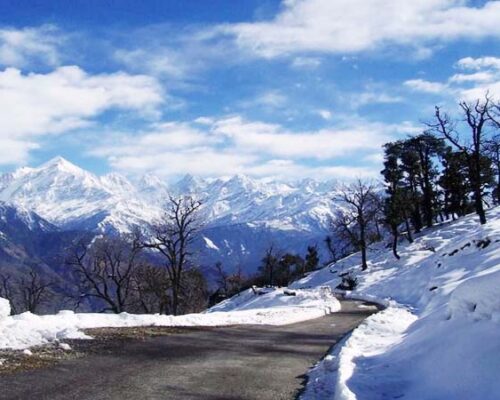
Jim Corbett National Park
Jim Corbett National Park is the oldest national park in India and was established in 1936 as Hailey National Park to protect the endangered Bengal tiger. It is located in Nainital district and Pauri Garhwal district of Uttarakhand and was named after Jim Corbett, a well known hunter and naturalist. The park was the first to come under the Project Tiger initiative.
The Park is located in the foothills of the Himalayas, in the midst of lush greenery and uneven mountains with varying heights, ranging from about 1300 feet to nearly 4000 feet.
The park has sub-Himalayan belt geographical and ecological characteristics. An ecotourism destination, it contains 488 different species of plants and a diverse variety of fauna.
More than 586 species of resident and migratory birds have been categorised, including the crested serpent eagle, blossom-headed parakeet and the red junglefowl — ancestor of all domestic fowl.[6] 33 species of reptiles, seven species of amphibians, seven species of fish and 36 species of dragonflies have also been recorded.[
The main attraction of tourists and wildlife enthusiasts to this Park is that the majestic view of Tiger. Other carnivores include the leopard, elephant, bear, and sambhar. Basking along the banks of the Ramganga are the slender gharial and the marsh crocodile.
The nearest town Ramnagar (51 km) is the ideal linkage for rail. Nearest airhead is at Pantnagar (110 km).
